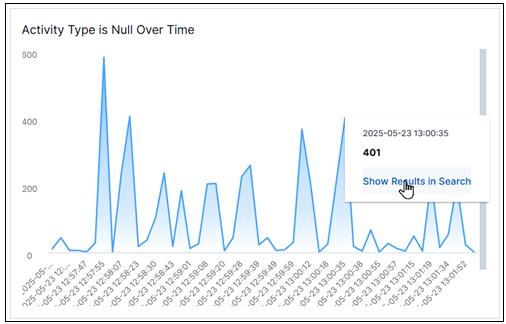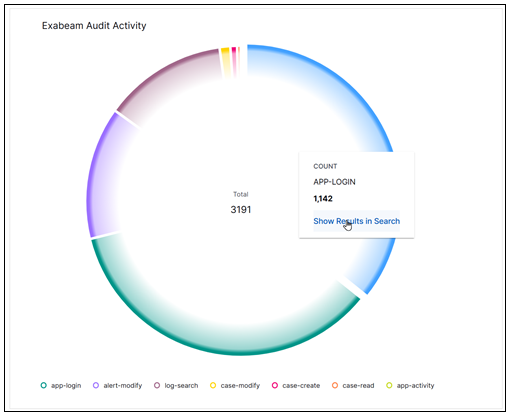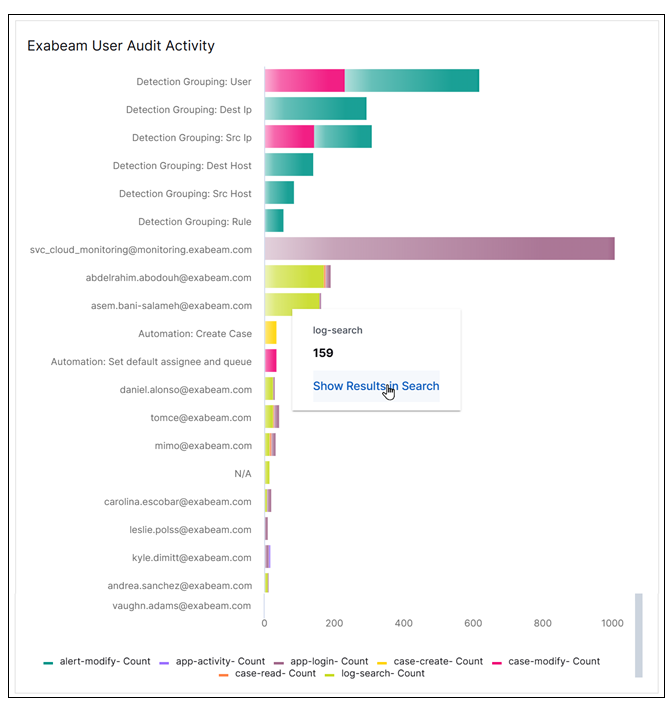- Dashboards
- Navigation Overview
- View and Interact with Dashboards
- View and Interact with Visualizations
- User Management
- Configure and Manage Dashboards
- Create a Dashboard
- Add a Visualization to a Dashboard
- Add a Text Tile
- Modify a Dashboard Layout
- Add Dashboard Filters
- Manage Automatic Refresh Rates
- Create a Scheduled Report
- Make a Dashboard Public
- Export and Import Dashboards
- Edit Dashboard Filters
- Edit Dashboard Details
- Duplicate a Dashboard
- Delete a Dashboard
- Configure and Manage Visualizations
- Create a Visualization
- Auto-Create a Visualization from a Natural Language Prompt
- Create a Visualization from a Search Query
- Add Visualizations from the Library to a Dashboard
- Modify a Visualization
- Configure Visualization Query Filters
- Include Context Filtering in Visualizations
- Make a Visualization Public
- Export and Import Visualizations
- Duplicate a Visualization
- Remove a Visualization from a Dashboard
- Delete Visualizations from the Library
- Configure and Manage Scheduled Reports
- Pre-Built Dashboards
- Advanced Analytics Dashboards
- AI/LLM Dashboards
- Case Manager Dashboards
- Compliance Dashboards
- Correlation Rules Dashboards
- Event Store Dashboards
- Access Grant and Revoke Activity
- Account Logout Summary
- Account Management Activity
- Application Security Event Summary
- Authenticated User Accounts on Hosts
- AWS CloudTrail Summary
- Data Loss Prevention Activity – Host-Based
- Data Loss Prevention Activity – User-Based
- Data Loss Prevention Activity Summary
- Default Account Access
- Default Credential Usage and Change Activity
- Denied Web Access Activity
- Disabled User Account Summary
- Discovered Attacks by Source and Destination
- Endpoint Detection and Response
- Failed Application Logon Activity
- Failed Audit Logs Summary
- Failed Host Login Attempt Counts by Users
- Failed VPN Login Attempts and Remote Session Timeouts
- Firewall Activity
- Firewall and Router Device Interfaces
- Insecure Authentication Attempts
- IOC Statistics
- Log Delay Insights
- Microsoft 365 Summary
- Microsoft Windows Overview
- Network Applications by Traffic Volume
- Policy Activity Summary
- Ports Usage Trend
- Privileged Access
- Privileged Access – User-Based
- Project Collateral
- Protocols by Network Traffic
- Remote Session Overview
- Security Alert Summary – Impacted Hosts
- Security Alert Summary – Origin Hosts
- Security Alert Summary – Users
- Successful Application Logon Activity
- Successful Database Login Activity
- Successful Physical Access
- Top Attackers
- User Account Creation Summary
- User Account Lockout Activity
- Vendor Authentication Activity
- Windows Audit Failure Summary by Hosts
- Windows Audit Failure Summary by Users
- Windows User Privilege Elevation
- Zscaler HTTP Dashboard
- Security Operations Center Management Dashboards
- Threat Center Dashboards
- Pre-Built Visualizations
- Anomalies - Use Case & MITRE Coverage
- Anomalies by Rule Name
- Anomalies by Use Case
- Anomalies Count Over Time
- Anomaly Distribution by MITRE Tactic & Score
- Application Count
- Closed Incidents
- Correlation Rules by Severity
- Correlation Rules Triggered Over Time
- Detected Anomalies
- Host-Based DLP Alerts Count
- Incidents Created
- Incident Summary by Incident Type
- Number of Hosts with DLP Alerts
- SOC Incident Distribution
- Top 5 Host-Based DLP Alert Categories
- Top 5 Protocols in Host-Based DLP Alerts
- Top 10 Host-Based DLP Alert Types
- Top 10 Hosts with DLP Alerts
- Top Activities per Top 10 Applications
- Top Users per Top 10 Applications
- Trend of Application Security Events
NIST 800-53 - Management
This management dashboard supports the National Institute of Standards and Technology (NIST) 800-53 requirements. It visualizes high-level information and trends that are necessary to understand the system health of your organization and the activities being performed in it. Each visualization on the dashboard is labeled with the number of the key control it supports from the standard. For detailed information about each visualization, click the following links to see the appropriate sections below:
By default, the dashboard is configure to show data for a date range of the last seven days. However, you can update the Event : Approx Log Time filter at the top of the dashboard to select a different range of data. To update the time range filter, click the arrow ( ) on the right, under the Edit button, to expand the filters panel. In the Event : Approx Log Time filter, select an operator from the first drop down menu and then enter or select values in the subsequent fields, depending on the operator you selected. To save your filter changes, click Apply on the right side of the filter panel. The updated filter is applied to the visualization.
) on the right, under the Edit button, to expand the filters panel. In the Event : Approx Log Time filter, select an operator from the first drop down menu and then enter or select values in the subsequent fields, depending on the operator you selected. To save your filter changes, click Apply on the right side of the filter panel. The updated filter is applied to the visualization.

Collectors with Unassigned Activity Type
This heat map breaks down the counts of collectors that do not have an activity type assigned. It can help you monitor and correct collectors with unassigned activity types so that information about those collectors is not excluded from dashboards and reports. Darker shading on the map indicates higher count numbers.
To view the information in the chart, move your pointer over the map segments to display the represented values. To drill down into a map segment and view the underlying events, click the segment and then click Show Results in Search.

Activity Type is Null Over Time
This area chart represents the count trends of log activity over a time range that does not include an activity type. It can help you monitor and correct logs with unassigned activity types so that information about those logs in not excluded from dashboards and reports.
To view the information in the chart, move your pointer over a graph area to display the data points and their represented values. To view the underlying events of a value, click a data point and then click Show Results in Search.

Exabeam Audit Activity
This pie chart illustrates the count proportions of what audit log activity is taking place in your organization. It can help you monitor and investigate unexpected activity in your audit log data. Access to audit logs should be limited.
To view the information in the chart, move your pointer over the graph slices to display the values they represent. To view the underlying events of a value, click a graph slice and then click Show Results in Search.

Exabeam User Audit Activity
This bar chart represents audit log activity by users in your organization. It can help you monitor and investigate unexpected user activity in your audit logs. Access to audit logs should be limited to users with job-related needs.
To view the information in the chart, move your pointer over the bar segments to display the values they represent. To drill into the underlying events, click a bar and then click Show Results in Search.
